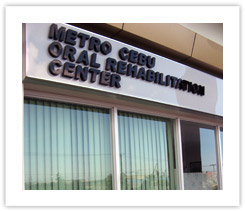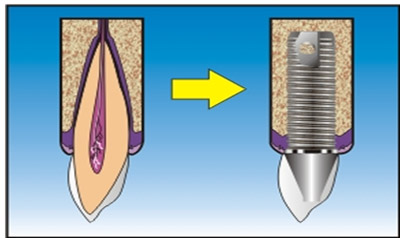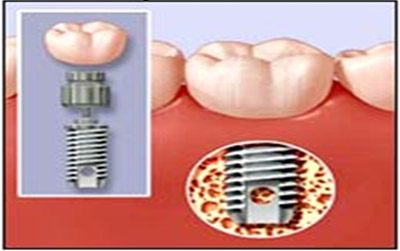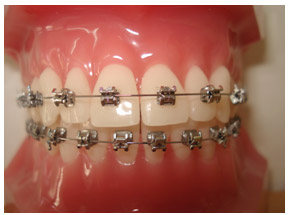Services
Oral Prophylaxis / Scaling (cleaning)Restorative Dentistry
Cosmetic Dentistry
Endodontic Dentistry
Prosthodontic Dentistry
Dental Implants ("alpha bio system")
Bone Grafts
Oral Surgery
Orthodontic Dentistry ("braces")


Clinic Address:
3rd Floor Room 308, Mob Bldg. (near Cebu Doctors' Hospital)
Gov. M.Roa Street, Capitol Site, Cebu City
NEWS / PROMOS
Hello Everyone! Good news! We are still offering a discounted rate on our Teeth Whitening / Bleaching. You can also avail a 10% discount on check up fees. Now, there's more reason to Smile the whole year through!
For Inquiries or Appointments, Please contact 09222-059946 or (6332) 511-7774

Prophylaxis. Dentist will remove the plaque and tartar that builds up and hardens on the tooth surface.
Scaling and root planing. This is a deep-cleaning, nonsurgical procedure, done w/ or w/out a local anesthetic, whereby plaque and tartar from above and below the gum line are scraped away and rough spots on the tooth root are made smooth (planing). Smoothing the rough spots removes bacteria and provides a clean surface for the gums to reattach to the teeth.
( Back to Top )
These are white tooth colored materials used to fill in the cavity of a tooth that has been decayed. Material used is of composite (3M).
Advantages of composite white fillings:
Dental Sealant/Pit and Fissure sealant is a material used to coat the top,
chewing surfaces of the back teeth. This coating protects the tooth from decay
and usually lasts a long time.
When should my child get dental sealants?
It is suitable to place sealants on the erupting first molars at the age of
6yrs. old followed by the erupting second molars. If sealants were applied in
conjunction with the appropriate use of fluoride, most tooth decay in children
could be prevented.
Are dental sealants just for kids?
The potential to develop pit and fissure decay begins early in life, so children
and teenagers are the candidates. But some adults at high risk of decay can benefit
from sealants as well.

Inlay and onlys are similar to dental fillings used to fill-in cavities or damaged teeth. But unlike fillings, inlays and onlays are made from porcelain or gold providing good strength for larger cavities.
A dental inlay covers a portion of the occlusal and proximal surfaces; it is used to replace small fillings. A dental onlay covers the proximal surfaces and most or all of the occlusal surfaces as well as the cusp of the tooth. It is used to replace very large fillings.
( Back to Top )

Teeth whitening is the process of removing stains and discoloration from teeth. This in turn can make people feel better about themselves and could have an instant white bright smile.
Our "BEYOND Power Whitening System" uses a cold- light technology and proprietary gel formulation (hydrogen peroxide and 20 nanometer silicon dioxide) combine to whiten teeth to their brightest in just 30 minutes w/out any side effects.
What is the difference between Beyond and other whitening methods?
This technique whitens right away w/out side effects. It doesn't damage your
teeth, and gives the best possible results.
How long does treatment take w/ BEYOND?
It only takes 30-40 minutes not longer than the time you'd have your haircut or
manicure done, or having a cup of coffee-it's that simple!
How safe is BEYOND?
This is absolutely safe because it uses cold light technology at a low temperature,
it cannot irritate the nerves of your teeth nor damage your teeth and gums.

Veneers are porcelain-ceramic wafer thin laminates or shells of tooth colored material that are "cemented" to the front surface of teeth to improve cosmetic appearance.
What Treatments or problems are veneers used for?
Stained Teeth - badly stained teeth that cannot be improved by teeth whitening
or prophylactic treatments can greatly be improved by dental veneers, which function
to cover and "hide" any existing stains on your natural teeth.
Damaged Teeth - A small chip on a tooth can quickly be repaired with veneers.
Gaps - spaces or gaps (diastemas) between your teeth can be easily closed using
dental veneers giving you a more uniform looking smile.
Crooked teeth - instead of having orthodontic treatment for crooked teeth which
may take up a year or longer, the veneers can provide an "instant orthodontics",
giving a similar end result of a straight and perfectly aligned looking smile.
( Back to Top )

Root canal treatment, also known as endodontic treatment, is a dental procedure in which the diseased or damaged pulp of a tooth is removed and the inside areas (the pulp chamber and root canals) are filled and sealed. Once root canal treatment is performed, the patient must have a crown placed over the tooth to protect it.
Causes of infected pulp:
Nerve and pulp can become irritated, inflamed and infected due to deep
decay, repeated dental procedures on a tooth and/or large fillings, a crack or chip in the tooth.
Indications of a Root Canal Treatment:
1. Severe toothache pain upon chewing or application of pressure
2. Prolonged sensitivity/pain to heat or cold temperatures
3. Swelling and tenderness in the nearby gums
4. A persistent or recurring pimple on the gums
5. Darkening of the tooth
6. Sometimes no symptoms are evident
( Back to Top )
A dental crown is a tooth-shaped "cap" that is placed over a tooth
to restore its shape and size, strength, and/or to improve its appearance.
Uses of a Dental Crown:
1. To protect and restore a weak tooth from breaking or to hold together parts of a cracked tooth
2. To cover and support a tooth with a large filling when there isn't a lot of tooth left
3. To hold a dental bridge in place
4. To cover misshaped or severely discolored teeth
5. To cover a dental implant and after root canal treatment.
Types of Crowns:
Permanent crowns can be made from all metal, porcelain-fused-to-metal, all resin, or all ceramic.
1. All-ceramic or all-porcelain dental crowns provide the best natural
color match than any other crown type and may be more suitable for people with metal allergies.
2. Porcelain fuse to gold is also the most esthetic choice for crowns.
It maybe expensive but offers the best natural look and is biocompatible to the tooth structure.
3. Porcelain-fused-to-metal dental crowns is next to all-ceramic crowns
and they look most like normal teeth. These crowns are also a good choice for front or back teeth.
4. Metals used in crowns include gold alloy, other alloys like a base-metal
alloy (for example, nickel or chromium). Less tooth structure needs to be removed
with metal crowns, and tooth wear to opposing teeth is kept to a minimum. Metal crowns
can withstand biting and chewing forces well. Also, they rarely chip or break. Metal
crowns are a good choice for molars.
5. All-resin dental crowns are less expensive than other crown types. However,
they wear down over time and are more prone to fractures than porcelain-fused-to-metal crowns.
These are used primarily for temporary crowns.

Dental bridges literally bridge the gap created by one or more missing teeth.
A bridge is made up of crowns for the teeth on either side of the gap /space.
These anchoring teeth are called "abutment teeth" (supporting teeth). The false
teeth that fills in the space/gap are called pontics. The crowns can be made from
gold, metal alloys, porcelain or a combination of these materials. Dental bridges
are supported by natural teeth or dental implants.
Advantages of Dental Bridges:
A denture is a removable tooth appliance in replacement for missing teeth
and surrounding tissues. Two types of dentures are available - complete and
partial dentures.
Complete Dentures
Complete dentures are used when all the teeth are missing. Made after
the teeth have been removed and the gum tissue has begun to heal, a conventional
denture is ready for placement in the mouth.
Partial Dentures("Valplast")
Partial dentures are used when some natural teeth remain or only a few teeth
are missing.
A removable partial denture usually consists of replacement teeth attached to
a pink or gum-colored plastic/rubberized base. It is removable and has internal
attachments.
Mouth guards are thin "u" shaped coverings worn over teeth, and often used
to protect teeth from injury from teeth grinding and during sports.
Who Needs a Mouth Guard?
Mouth guards can be used by anyone - both children and adults - who grind their
teeth at night who play contact sports such as football, boxing, soccer, basketball.
However, even those participating in noncontact sports (for example, gymnastics) and
any recreational activity (for example, skateboarding, mountain biking) that might pose
a risk of injury to the mouth would benefit from wearing a protective mouth guard.
( Back to Top )


Dental implants are metallic cylinders that are placed into the jawbone where
original teeth once existed. These root-like cylinders are used to secure a replacement
tooth in place in a spot where a tooth is missing. Implants provide a strong foundation
and support for fixed (permanent) or removable replacement teeth that are made to match
your natural teeth.
Dental implants are made of various biomaterials. Most commonly, a surgical
metal called "titanium" is used, because it is the most compatible with human biology.
They are surgically placed in the jawbone, right in the dentist's office,
using a local anesthetic. Patients who have good oral hygiene and take care
of their new teeth can enjoy implants that last a lifetime.
Benefits of Dental Implants:
( Back to Top )
Bone grafting involves using fragments of your own bone, synthetic bone, or donated bone to replace bone destroyed by periodontal disease. The grafts serve as a platform for the regrowth of bone, which restores stability to teeth. New technology, called "tissue engineering", encourages your own body to regenerate bone and tissue at an accelerated rate.
( Back to Top )
Tooth extraction is removal of teeth and may be done when:

"Wisdom teeth", otherwise known as third molars, are the last set of teeth to develop. More often, one or more of these third molars fails to emerge in proper alignment or fails to fully emerge through the gum line and becomes entrapped or "impacted" between the jawbone and the gum tissue.
Why is surgical removal of impacted 3rd molar recommended?
1. Impacted 3rd molar can result to swelling, pain and infection of the gum tissue
around the
wisdom tooth.
2. Impacted wisdom tooth can cause permanent damage to nearby gums, teeth and bone.
3. This can further lead to cyst formation/tumors which can affect the jawbone.
( Back to Top )

1. Self -ligating brackets consists of both clear and metal parts allowing braces
to be less visible without the need of elastic bands. This enables less frictional force
and in certain cases faster treatment outcome. This is the most convenient method used
for orthodontics.
2. Metal braces are smaller than ever before and you can express your individuality.
Part of the fun of having braces is choosing different-colored elastics at each appointment.
3. Clear or ceramic braces make treatment nearly invisible. The polymer brackets makes
it translucent while ceramic brackets are tooth-colored, making it one of the most
popular aesthetic choices in braces today.
4. Removable appliances include retainers and active plates.
Retainers are normally worn after fixed braces are removed in maintaining
teeth in preventing relapses.
Active plates are commonly worn by children in guiding their erupting teeth
into specific positions.
These are self ligating brackets and are the smallest brackets in the market.
You benefit from great aesthetics. This system keeps your appointments with your
dentist short and reduce the overall treatment time drastically,thus achieving a
faster result.
Advantages of Forestadent:
1. Great aesthetic because of its small size bracket
2. Speedy treatment due to low friction and no binding between wire and the bracket
3. Shorter appointment due to ease in handling by the dentist
4. Biocompatible because its is Ni-Free
5. Comfortable because it has no sharp edges
6. Reliable in a way that it minimizes bracket debonding
( Back to Top )